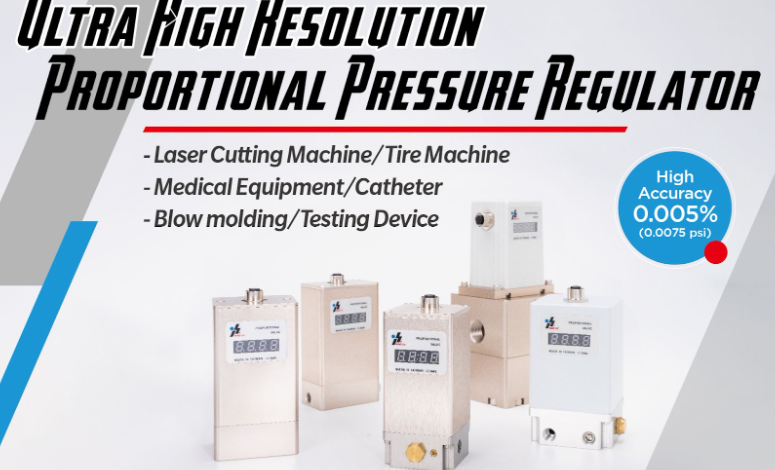Electronic Proportional Pressure Regulators and Their Introduction

An electronic proportional pressure regulator is a device intended to monitor and adjust the flow and pressure of air and gas and either increase or decrease with the use of electronic signals. They use sophisticated sensors and control systems rather than traditional mechanical systems to attain precision in real time. These devices are widely used in automation, robotics, and healthcare alongside other industries with an emphasis on accuracy and stability.
These devices are at the intersection of electronics and pneumatics, which is critical in providing industries with dependable systems designed to maintain pressure in intricate, dynamic systems.
How Do Electronic Pressure Regulators Work in Real-Time Control?
Working Mechanism
Electronic pressure regulators work with the aid of three key elements.
Input Signal: An input that is either electrical or digital in nature. It is received from devices such as the controllers and PLC.
Sensor Feedback: Detecting the actual pressure level in a system that is contained.
Controller Adjustment: This element is responsible for a comparison between a given pressure and the actual pressure. It is to be noted that changes are customarily made.
Step-By-Step Process:
- The regulator acts on signals it gets received from the controller. Internal sensors that measure the level of pressure.
- The regulator adjusts the flow of air appropriately.
- These steps are repeated in order to maintain a constant output pressure.
See also: Understanding The Importance Of fstn lcd module In Technology
Principal Benefits of Electro-Pneumatic Regulators
Electro-pneumatic regulators, or electronic proportional regulators, have a number of benefits when compared to traditional regulators.
1. Greater Precision
Output pressures are controlled with a level of precision critical to the healthcare and robotics industries.
2. Other regulators with faster reaction times
These regulators minimize lag response to changes in demand to avoid clustered intervals within automated processes.
3. Better Energy Saving
There’s less loss in loaded energy as precise and proper automation changes the set defaults.
4. Plug and Play
They are capable of direct interfacing with PLCs, computers, regulators, and other automation control peripherals.
Condensed Benefits Summary
- Narrowed tolerances of set parameters
- Higher volume of output
- Less human oversight
- Lower system idle time
Recurring Issues with Suggestions on Solutions in Electronic Proportional Regulators
Despite the high reliability of the electronic proportional pressure regulator, certain issues can arise.
Using Electronic Proportional Pressure Regulators
The integration of advanced electronic technology in various industries has greatly streamlined processes. Electronic proportional regulators are applied in:
- Robotics: in the refined operation of robotic actuators and arms and gripping systems.
- Medical: in the regulation of oxygen flow in ventilators and anesthesia machines.
- Automotive: during precision testing and on calibration and assembly line automation systems.
- Packaging: during cutting, labeling, and sealing that must be done with the application of stable pressure.
- Food and beverage: during the packaging of products that must meet the requirements of clean, precise, and hygienic.
- Laboratory applications: during experiments that necessitate the maintenance of stable low pressure.
Because of the sensitivity and precision that electronic proportional pressure regulators are capable of providing, they are essential to maintaining safety during work processes.
Proportional regulators are not excluded from the evolution towards smart automation, which is a recurring trend in industries adopting Industry 4.0.
Anticipated Improvements:
Remote Observing IoT-enabled Regulators: Monitoring and controlling in real time over the internet
Integration of Artificial Intelligence: Maintaining and managing predictive systems with enhanced accuracy and intelligence
Reduction in Size: Smaller and more compact regulators for use in the medical field and in robotics
Improved Models about Energy: More sophisticated models that help save even more energy
The expected outcome is the development of IoT-enabled predictive maintenance tools that are more intelligent and energy-efficient, directly aligned with more advanced automation systems.
Conclusions:
The automation industry has been revolutionized by the use of electronic proportional pressure regulators, and they are indispensable today. Printed IoT blueprints combined with qualitative predictions have changed the field of robotics, medical spheres, automotive systems, and even packaging, making them more seamless, efficient, and reliable.
The future systems of automation are bound to be more sophisticated, and hence the role of electronic proportional regulators is only bound to increase with new and emerging technologies in AI and IoT.



